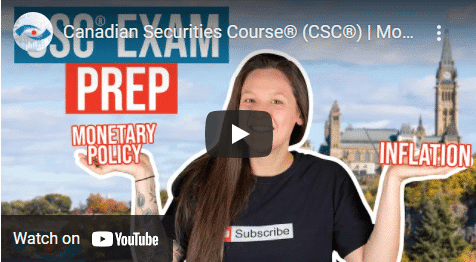This week, we received a submission from a student on a concept called disinflation. She knew what inflation was and deflation too, but disinflation confused her. Here at SeeWhy Learning, we understand how powerful memory aids can be; especially visual ones like this balloon. Not only is my happy friend here going to help you understand this concept, he’s going to help you remember it on exam day, too.
This question is basically testing on whether or not you know what the term ‘disinflation’ means. Most people know what inflation means even before they registered in a financial services course. It’s a fairly common term. You hear it on the news all the time. Inflation is essentially a measure of how much the price of the things that we as Canadians buy or consume on a regular basis increases from one period to another.
If you’ve added the eLearning video lessons to your account, you’ll find one there called ‘Inflation and Real Return’. We have a pretty in-depth explanation on this concept and in the study guide as well. At this point, I’m going to assume that you have a pretty good handle on inflation. If you don’t, that’s okay. Go back and watch that video, give the study guide another quick read through, and then come back and finish this Coach’s Hangout video response video.
Let me just run through a quick summary of inflation. A second ago I said that inflation measures how much prices increase from one period to another. But do you think that the government, or more specifically Statistics Canada, actually tracks the price of every single good and service in the country? Of course not. That would be virtually impossible. So instead the government tracks the price of what we call a ‘basket of goods’.
Now this all ties into something called the ‘consumer price index’ or CPI’. That’s an acronym you might’ve seen before. The ‘goods in the basket’ are a fair representation of what most Canadians buy on a regular basis. It includes things like gas and milk and haircuts and appliances and smartphones … that sort of stuff. It doesn’t include things like rare manuscripts and private jets and NHL season tickets. But don’t worry, you don’t need to know all of the products that make up the CPI for your exam. You just have to get that if the price of this ‘basket of goods’ increases by say 3% from one period to the next, we would say that inflation has been 3% over that period. All right. So that’s the basic technical definition of inflation, but let me demonstrate for you.
Let’s say that this balloon is the consumer price index. Let’s blow up the balloon and introduce a little inflation into the economy. It’s getting bigger, right? Prices are getting higher. That’s obviously inflation. But if we let a little air out, what do we call that? Obviously ‘deflation’, which is just the opposite of inflation and is when prices are actually falling.
With this in mind, let’s take a peek at the answers [in the video]. We see the answer ‘a’, “A reduction in prices from year to year” is essentially the definition of deflation, not disinflation, like this question is asking about. So let’s go ahead and eliminate answer ‘a’. On a side note, while we’re talking about deflation, what would you say if I asked you, “Do you think deflation is a good thing?”. Your first instinct would probably be to answer, “Heck yeah, who doesn’t like lower prices?”. But in reality, deflation is actually really bad for the economy. Just like letting the air out of the balloon, deflation is like letting air out of the economy. For example, if you needed a brand new car, but you knew cars were going to be cheaper, two, three, four, or six months from now, you’d likely push off your purchase until later. If everybody did that for all of the goods that are in that basket, the things that Canadians buy on a regular basis, sales would fall off a cliff, profits would really fall and people would end up without work. It’s not a good thing. So that’s deflation.
What about disinflation? Well, a lot of people think that deflation and disinflation are the same thing. They sound so close. And, in fact, many students jump right on answer ‘a’ in this question, because it sounds right. That’s not the case. In fact, disinflation is actually a form of inflation. Let me show you.
[Blowing up the balloon slightly] That’s Inflation. [Blowing the balloon up more] That is inflation, too. [Then blowing it up less then the first two times] And so is that, but you’ll notice that I wasn’t inflating the balloon as quickly. It still got bigger, but not at the same rate as it was before. That’s disinflation. It’s a reduction in the rate of inflation. For example, if inflation was 3%, but the next period it is only 2%, it would be called disinflation. We still have inflation, just not as high as it was before. In other words, prices are still increasing, just not as fast. If we look at the answers [in the video], we see answer ‘b’ “A reduction in inflation from year to year”. That looks good. So, let’s go ahead and pick that for now. We still have inflation – it is just less inflation. And that’s the right answer. Cool. Okay.So let’s look at the other answers. Answer ‘c’, “A reduction in deflation from year to year”. Well, that may be an indication that there could be some light at the end of the tunnel if we were in some pretty tough times with an extended period of deflation, but that’s not disinflation; again, disinflation is still inflation. It’s just less inflation.
And finally, answer ‘d’, well, we completely made this up – it’s just a distractor.
Actually. Let me tie this back now to the “Top 10 Exam Tips” video. One of the things that we addressed there is that sometimes on the exam, if you come across one of these really wordy answers, when all of the other ones are shorter, it could very well be a red herring. Again, we addressed that in the ‘Top 10 Trainer Tips’, another one of our videos that you’ll find on our YouTube Channel. All right, thanks everybody. I really appreciate you dropping into the Coach’s Hangout”. Keep those submissions coming. Good luck on your exam.
Recent Videos

Monetary & Fiscal Policy Part 2

Monetary & Fiscal Policy







